Abstract
Mulibrey nanism (MUL) is an autosomal recessive disorder with unknown basic metabolic defect. It is characterized by growth failure of prenatal onset, characteristic dysmorphic features, constrictive pericardium, hepatomegaly as a consequence of constrictive pericardium, yellowish dots in the ocular fundi, and J-shaped sella turcica. Hypoplasia of various endocrine glands, causing hormone deficiencies, is common. Here we report the assignment of the MUL gene, by linkage analysis in Finnish families, to a 7-cM region flanked by D17S1799 and D17S948 on chromosome 17q. Multipoint linkage analysis gave a maximum LOD score of 5.01 at loci D17S1606-D17S1853 and at D17S1604. The estimate of the critical MUL region was further narrowed to within approximately 250 kb of marker D17S1853 by linkage disequilibrium analysis. Positional candidate genes that belong to the growth hormone and homeobox B gene clusters were excluded. These data confirm the autosomal recessive inheritance of MUL and allow highly focused attempts to clone the gene.
Full text
PDF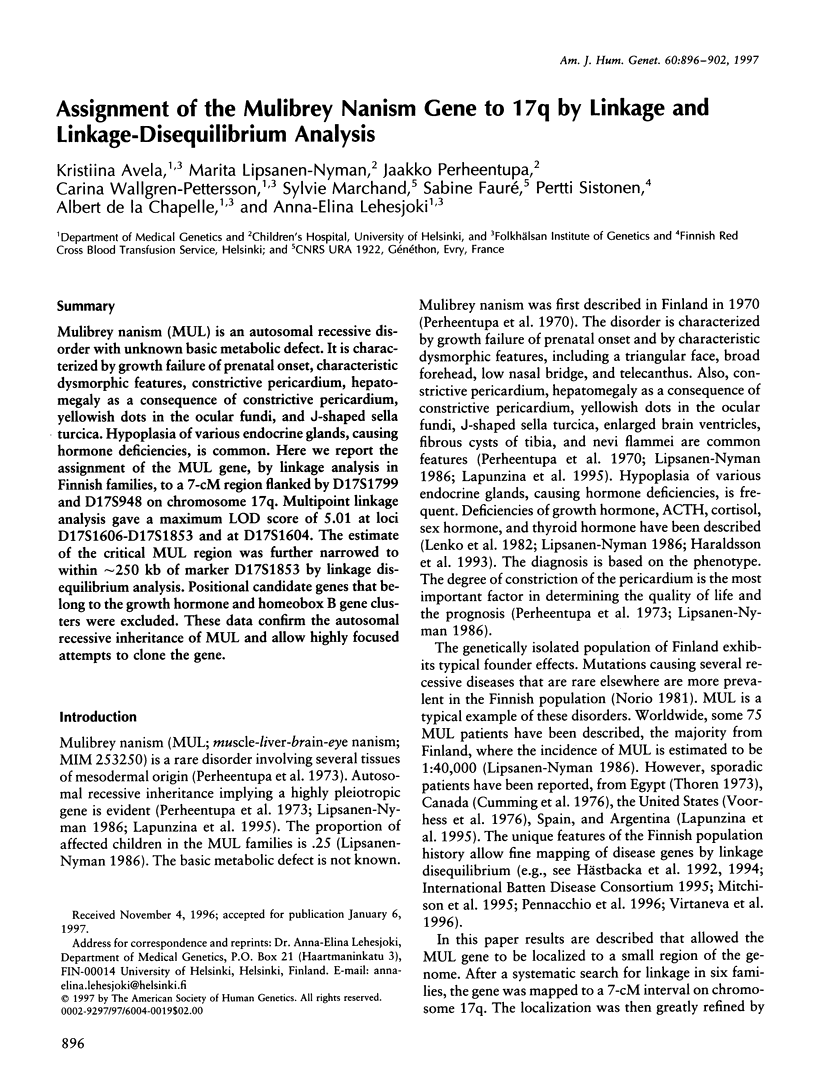
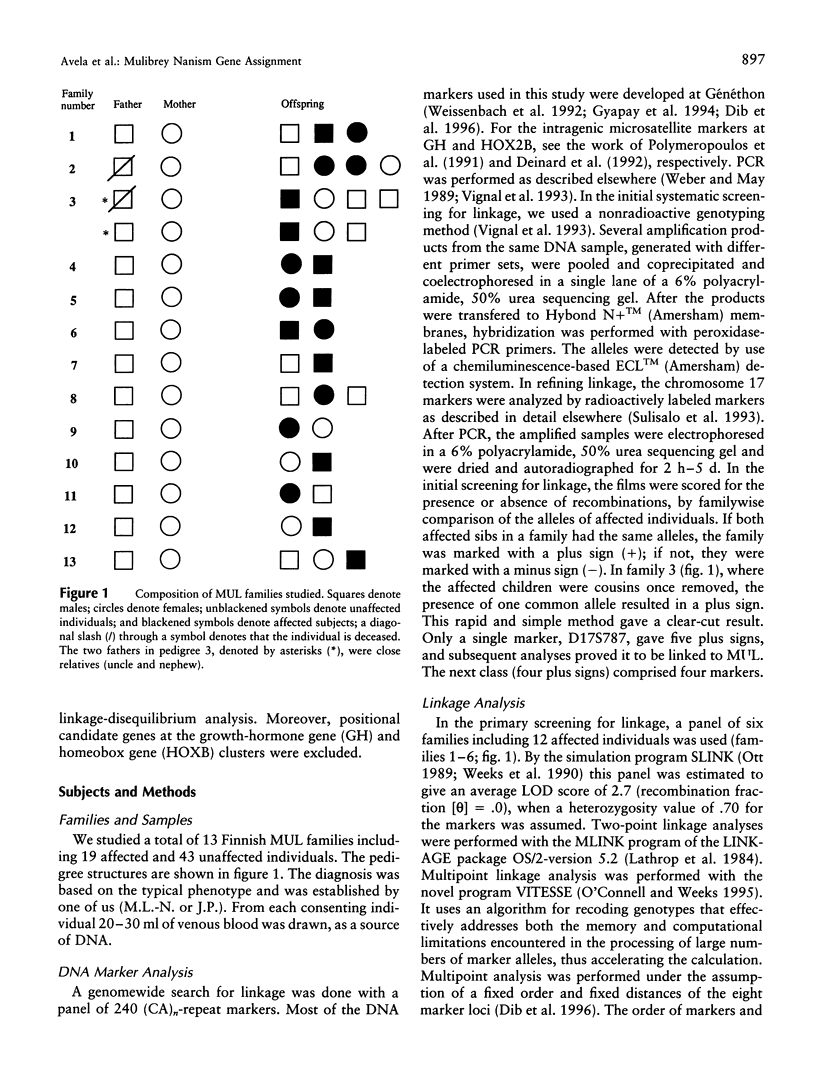
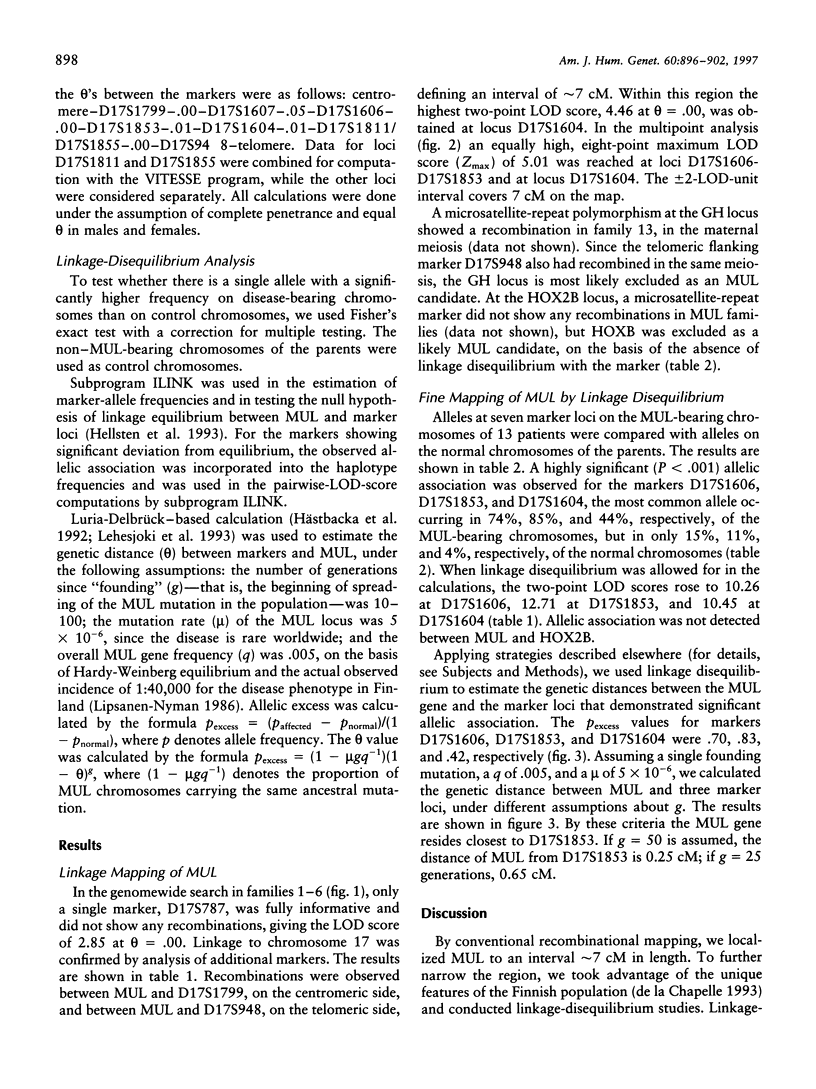
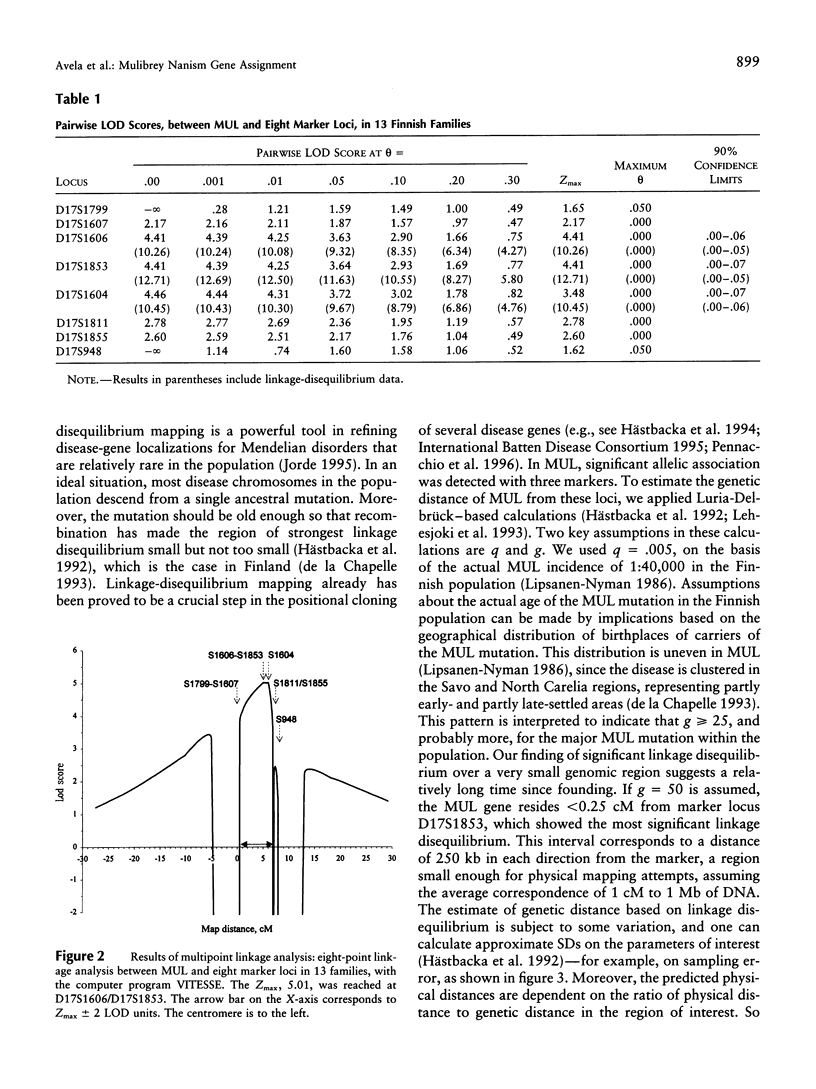
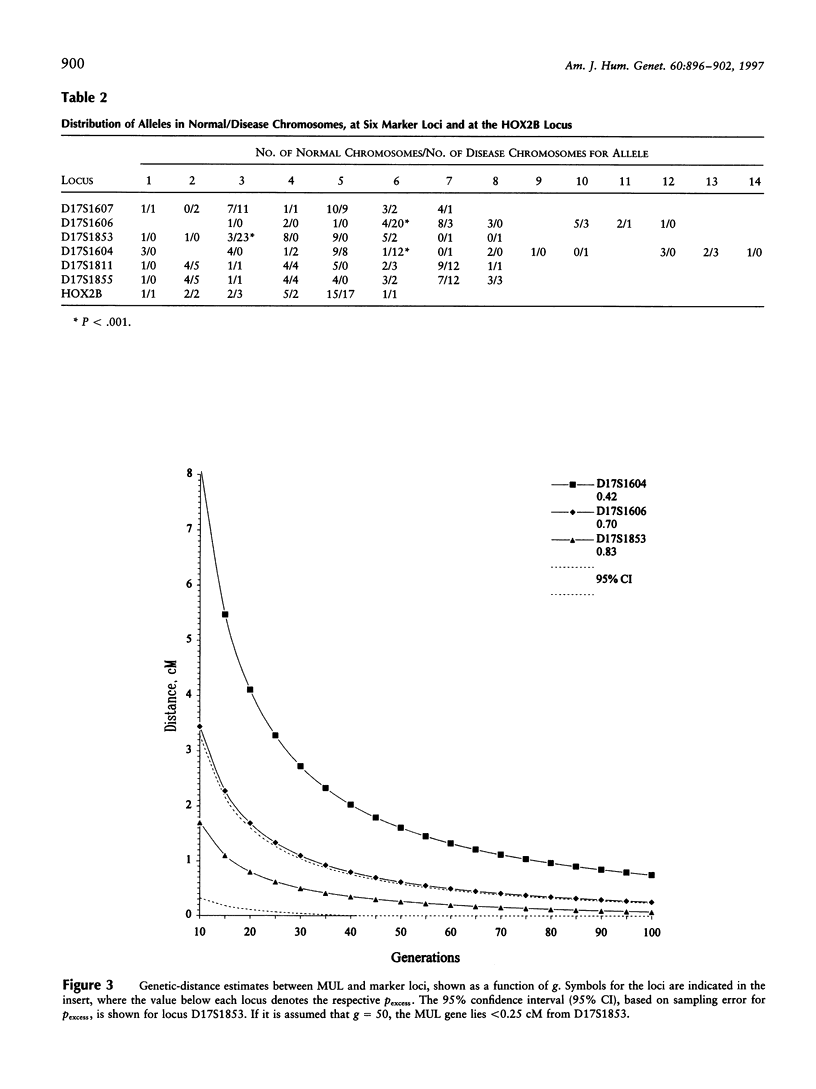
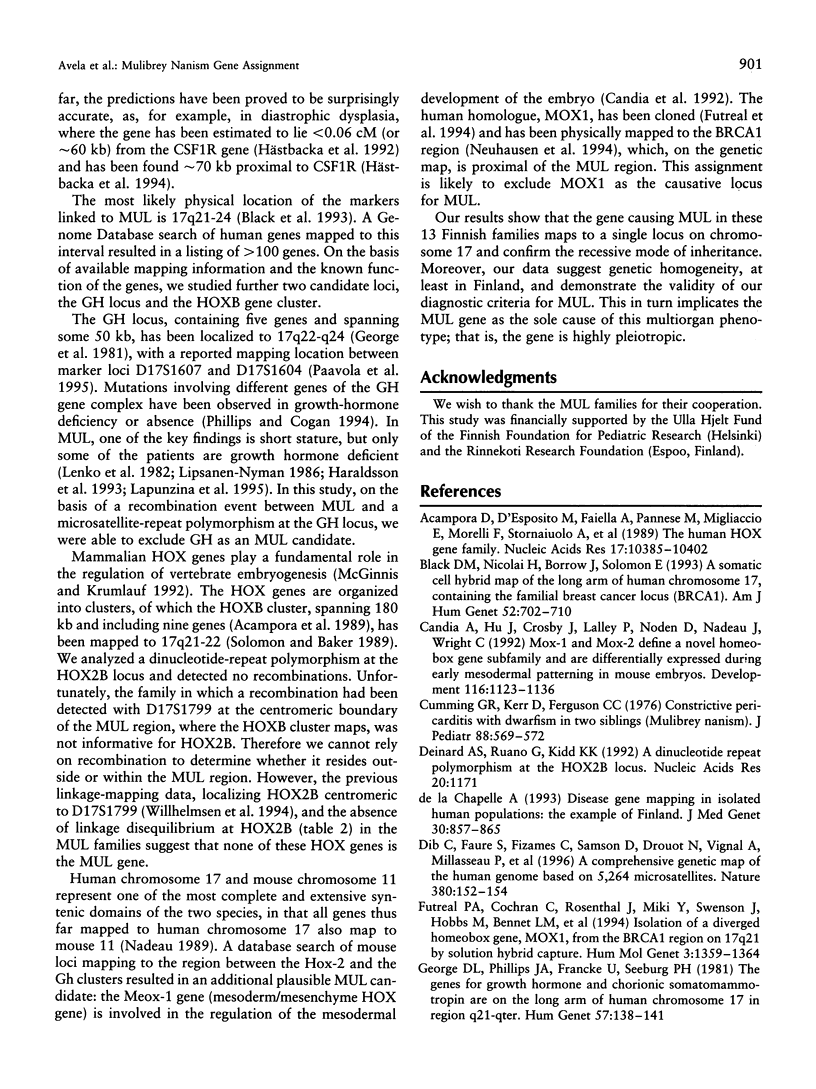
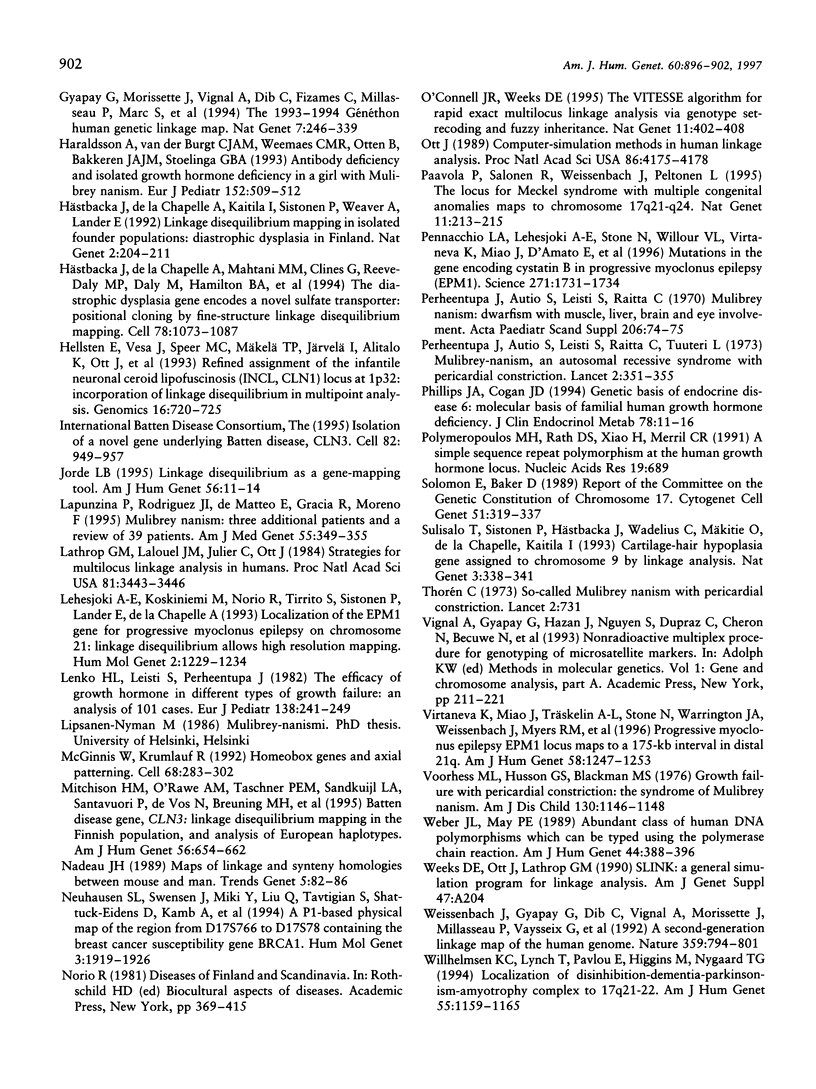
Selected References
These references are in PubMed. This may not be the complete list of references from this article.
- Acampora D., D'Esposito M., Faiella A., Pannese M., Migliaccio E., Morelli F., Stornaiuolo A., Nigro V., Simeone A., Boncinelli E. The human HOX gene family. Nucleic Acids Res. 1989 Dec 25;17(24):10385–10402. doi: 10.1093/nar/17.24.10385. [DOI] [PMC free article] [PubMed] [Google Scholar]
- Black D. M., Nicolai H., Borrow J., Solomon E. A somatic cell hybrid map of the long arm of human chromosome 17, containing the familial breast cancer locus (BRCA1). Am J Hum Genet. 1993 Apr;52(4):702–710. [PMC free article] [PubMed] [Google Scholar]
- Candia A. F., Hu J., Crosby J., Lalley P. A., Noden D., Nadeau J. H., Wright C. V. Mox-1 and Mox-2 define a novel homeobox gene subfamily and are differentially expressed during early mesodermal patterning in mouse embryos. Development. 1992 Dec;116(4):1123–1136. doi: 10.1242/dev.116.4.1123. [DOI] [PubMed] [Google Scholar]
- Cumming G. R., Kerr D., Ferguson C. C. Constrictive pericarditis with dwarfism in two siblings (mulibrey nanism). J Pediatr. 1976 Apr;88(4 Pt 1):569–572. doi: 10.1016/s0022-3476(76)80008-x. [DOI] [PubMed] [Google Scholar]
- Deinard A. S., Ruano G., Kidd K. K. A dinucleotide repeat polymorphism at the HOX2B locus. Nucleic Acids Res. 1992 Mar 11;20(5):1171–1171. doi: 10.1093/nar/20.5.1171-a. [DOI] [PMC free article] [PubMed] [Google Scholar]
- Dib C., Fauré S., Fizames C., Samson D., Drouot N., Vignal A., Millasseau P., Marc S., Hazan J., Seboun E. A comprehensive genetic map of the human genome based on 5,264 microsatellites. Nature. 1996 Mar 14;380(6570):152–154. doi: 10.1038/380152a0. [DOI] [PubMed] [Google Scholar]
- Futreal P. A., Cochran C., Rosenthal J., Miki Y., Swenson J., Hobbs M., Bennett L. M., Haugen-Strano A., Marks J., Barrett J. C. Isolation of a diverged homeobox gene, MOX1, from the BRCA1 region on 17q21 by solution hybrid capture. Hum Mol Genet. 1994 Aug;3(8):1359–1364. doi: 10.1093/hmg/3.8.1359. [DOI] [PubMed] [Google Scholar]
- George D. L., Phillips J. A., 3rd, Francke U., Seeburg P. H. The genes for growth hormone and chorionic somatomammotropin are on the long arm of human chromosome 17 in region q21 to qter. Hum Genet. 1981;57(2):138–141. doi: 10.1007/BF00282009. [DOI] [PubMed] [Google Scholar]
- Gyapay G., Morissette J., Vignal A., Dib C., Fizames C., Millasseau P., Marc S., Bernardi G., Lathrop M., Weissenbach J. The 1993-94 Généthon human genetic linkage map. Nat Genet. 1994 Jun;7(2 Spec No):246–339. doi: 10.1038/ng0694supp-246. [DOI] [PubMed] [Google Scholar]
- Haraldsson A., van der Burgt C. J., Weemaes C. M., Otten B., Bakkeren J. A., Stoelinga G. B. Antibody deficiency and isolated growth hormone deficiency in a girl with Mulibrey nanism. Eur J Pediatr. 1993 Jun;152(6):509–512. doi: 10.1007/BF01955061. [DOI] [PubMed] [Google Scholar]
- Hellsten E., Vesa J., Speer M. C., Mäkelä T. P., Järvelä I., Alitalo K., Ott J., Peltonen L. Refined assignment of the infantile neuronal ceroid lipofuscinosis (INCL, CLN1) locus at 1p32: incorporation of linkage disequilibrium in multipoint analysis. Genomics. 1993 Jun;16(3):720–725. doi: 10.1006/geno.1993.1253. [DOI] [PubMed] [Google Scholar]
- Hästbacka J., de la Chapelle A., Kaitila I., Sistonen P., Weaver A., Lander E. Linkage disequilibrium mapping in isolated founder populations: diastrophic dysplasia in Finland. Nat Genet. 1992 Nov;2(3):204–211. doi: 10.1038/ng1192-204. [DOI] [PubMed] [Google Scholar]
- Hästbacka J., de la Chapelle A., Mahtani M. M., Clines G., Reeve-Daly M. P., Daly M., Hamilton B. A., Kusumi K., Trivedi B., Weaver A. The diastrophic dysplasia gene encodes a novel sulfate transporter: positional cloning by fine-structure linkage disequilibrium mapping. Cell. 1994 Sep 23;78(6):1073–1087. doi: 10.1016/0092-8674(94)90281-x. [DOI] [PubMed] [Google Scholar]
- Jorde L. B. Linkage disequilibrium as a gene-mapping tool. Am J Hum Genet. 1995 Jan;56(1):11–14. [PMC free article] [PubMed] [Google Scholar]
- Lapunzina P., Rodríguez J. I., de Matteo E., Gracia R., Moreno F. Mulibrey nanism: three additional patients and a review of 39 patients. Am J Med Genet. 1995 Jan 30;55(3):349–355. doi: 10.1002/ajmg.1320550320. [DOI] [PubMed] [Google Scholar]
- Lathrop G. M., Lalouel J. M., Julier C., Ott J. Strategies for multilocus linkage analysis in humans. Proc Natl Acad Sci U S A. 1984 Jun;81(11):3443–3446. doi: 10.1073/pnas.81.11.3443. [DOI] [PMC free article] [PubMed] [Google Scholar]
- Lehesjoki A. E., Koskiniemi M., Norio R., Tirrito S., Sistonen P., Lander E., de la Chapelle A. Localization of the EPM1 gene for progressive myoclonus epilepsy on chromosome 21: linkage disequilibrium allows high resolution mapping. Hum Mol Genet. 1993 Aug;2(8):1229–1234. doi: 10.1093/hmg/2.8.1229. [DOI] [PubMed] [Google Scholar]
- Lenko H. L., Leisti S., Perheentupa J. The efficacy of growth hormone in different types of growth failure. An analysis of 101 cases. Eur J Pediatr. 1982 May;138(3):241–249. doi: 10.1007/BF00441210. [DOI] [PubMed] [Google Scholar]
- McGinnis W., Krumlauf R. Homeobox genes and axial patterning. Cell. 1992 Jan 24;68(2):283–302. doi: 10.1016/0092-8674(92)90471-n. [DOI] [PubMed] [Google Scholar]
- Mitchison H. M., O'Rawe A. M., Taschner P. E., Sandkuijl L. A., Santavuori P., de Vos N., Breuning M. H., Mole S. E., Gardiner R. M., Järvelä I. E. Batten disease gene, CLN3: linkage disequilibrium mapping in the Finnish population, and analysis of European haplotypes. Am J Hum Genet. 1995 Mar;56(3):654–662. [PMC free article] [PubMed] [Google Scholar]
- Nadeau J. H. Maps of linkage and synteny homologies between mouse and man. Trends Genet. 1989 Mar;5(3):82–86. doi: 10.1016/0168-9525(89)90031-0. [DOI] [PubMed] [Google Scholar]
- Neuhausen S. L., Swensen J., Miki Y., Liu Q., Tavtigian S., Shattuck-Eidens D., Kamb A., Hobbs M. R., Gingrich J., Shizuya H. A P1-based physical map of the region from D17S776 to D17S78 containing the breast cancer susceptibility gene BRCA1. Hum Mol Genet. 1994 Nov;3(11):1919–1926. doi: 10.1093/hmg/3.11.1919. [DOI] [PubMed] [Google Scholar]
- O'Connell J. R., Weeks D. E. The VITESSE algorithm for rapid exact multilocus linkage analysis via genotype set-recoding and fuzzy inheritance. Nat Genet. 1995 Dec;11(4):402–408. doi: 10.1038/ng1295-402. [DOI] [PubMed] [Google Scholar]
- Ott J. Computer-simulation methods in human linkage analysis. Proc Natl Acad Sci U S A. 1989 Jun;86(11):4175–4178. doi: 10.1073/pnas.86.11.4175. [DOI] [PMC free article] [PubMed] [Google Scholar]
- Paavola P., Salonen R., Weissenbach J., Peltonen L. The locus for Meckel syndrome with multiple congenital anomalies maps to chromosome 17q21-q24. Nat Genet. 1995 Oct;11(2):213–215. doi: 10.1038/ng1095-213. [DOI] [PubMed] [Google Scholar]
- Pennacchio L. A., Lehesjoki A. E., Stone N. E., Willour V. L., Virtaneva K., Miao J., D'Amato E., Ramirez L., Faham M., Koskiniemi M. Mutations in the gene encoding cystatin B in progressive myoclonus epilepsy (EPM1) Science. 1996 Mar 22;271(5256):1731–1734. doi: 10.1126/science.271.5256.1731. [DOI] [PubMed] [Google Scholar]
- Perheentupa J., Autio S., Leisti S., Raitta C. Mulibrey-nanism: dwarfism with muscle, liver, brain and eye involvement. Acta Paediatr Scand Suppl. 1970;206(Suppl):74+–74+. doi: 10.1111/j.1651-2227.1970.tb14591.x. [DOI] [PubMed] [Google Scholar]
- Perheentupa J., Autio S., Leisti S., Raitta C., Tuuteri L. Mulibrey nanism, an autosomal recessive syndrome with pericardial constriction. Lancet. 1973 Aug 18;2(7825):351–355. doi: 10.1016/s0140-6736(73)93193-0. [DOI] [PubMed] [Google Scholar]
- Phillips J. A., 3rd, Cogan J. D. Genetic basis of endocrine disease. 6. Molecular basis of familial human growth hormone deficiency. J Clin Endocrinol Metab. 1994 Jan;78(1):11–16. doi: 10.1210/jcem.78.1.8288694. [DOI] [PubMed] [Google Scholar]
- Polymeropoulos M. H., Rath D. S., Xiao H., Merril C. R. A simple sequence repeat polymorphism at the human growth hormone locus. Nucleic Acids Res. 1991 Feb 11;19(3):689–689. doi: 10.1093/nar/19.3.689. [DOI] [PMC free article] [PubMed] [Google Scholar]
- Solomon E., Barker D. F. Report of the committee on the genetic constitution of chromosome 17. Cytogenet Cell Genet. 1989;51(1-4):319–337. doi: 10.1159/000132797. [DOI] [PubMed] [Google Scholar]
- Sulisalo T., Sistonen P., Hästbacka J., Wadelius C., Mäkitie O., de la Chapelle A., Kaitila I. Cartilage-hair hypoplasia gene assigned to chromosome 9 by linkage analysis. Nat Genet. 1993 Apr;3(4):338–341. doi: 10.1038/ng0493-338. [DOI] [PubMed] [Google Scholar]
- Thorén C. So-called mulibrey nanism with pericardial constriction. Lancet. 1973 Sep 29;2(7831):731–731. doi: 10.1016/s0140-6736(73)92557-9. [DOI] [PubMed] [Google Scholar]
- Virtaneva K., Miao J., Träskelin A. L., Stone N., Warrington J. A., Weissenbach J., Myers R. M., Cox D. R., Sistonen P., de la Chapelle A. Progressive myoclonus epilepsy EPM1 locus maps to a 175-kb interval in distal 21q. Am J Hum Genet. 1996 Jun;58(6):1247–1253. [PMC free article] [PubMed] [Google Scholar]
- Voorhess M. L., Husson G. S., Blackman M. S. Growth failure with pericardial constriction. The syndrome of mulibrey nanism. Am J Dis Child. 1976 Oct;130(10):1146–1148. doi: 10.1001/archpedi.1976.02120110108017. [DOI] [PubMed] [Google Scholar]
- Weber J. L., May P. E. Abundant class of human DNA polymorphisms which can be typed using the polymerase chain reaction. Am J Hum Genet. 1989 Mar;44(3):388–396. [PMC free article] [PubMed] [Google Scholar]
- Weissenbach J., Gyapay G., Dib C., Vignal A., Morissette J., Millasseau P., Vaysseix G., Lathrop M. A second-generation linkage map of the human genome. Nature. 1992 Oct 29;359(6398):794–801. doi: 10.1038/359794a0. [DOI] [PubMed] [Google Scholar]
- Wilhelmsen K. C., Lynch T., Pavlou E., Higgins M., Nygaard T. G. Localization of disinhibition-dementia-parkinsonism-amyotrophy complex to 17q21-22. Am J Hum Genet. 1994 Dec;55(6):1159–1165. [PMC free article] [PubMed] [Google Scholar]
- de la Chapelle A. Disease gene mapping in isolated human populations: the example of Finland. J Med Genet. 1993 Oct;30(10):857–865. doi: 10.1136/jmg.30.10.857. [DOI] [PMC free article] [PubMed] [Google Scholar]


